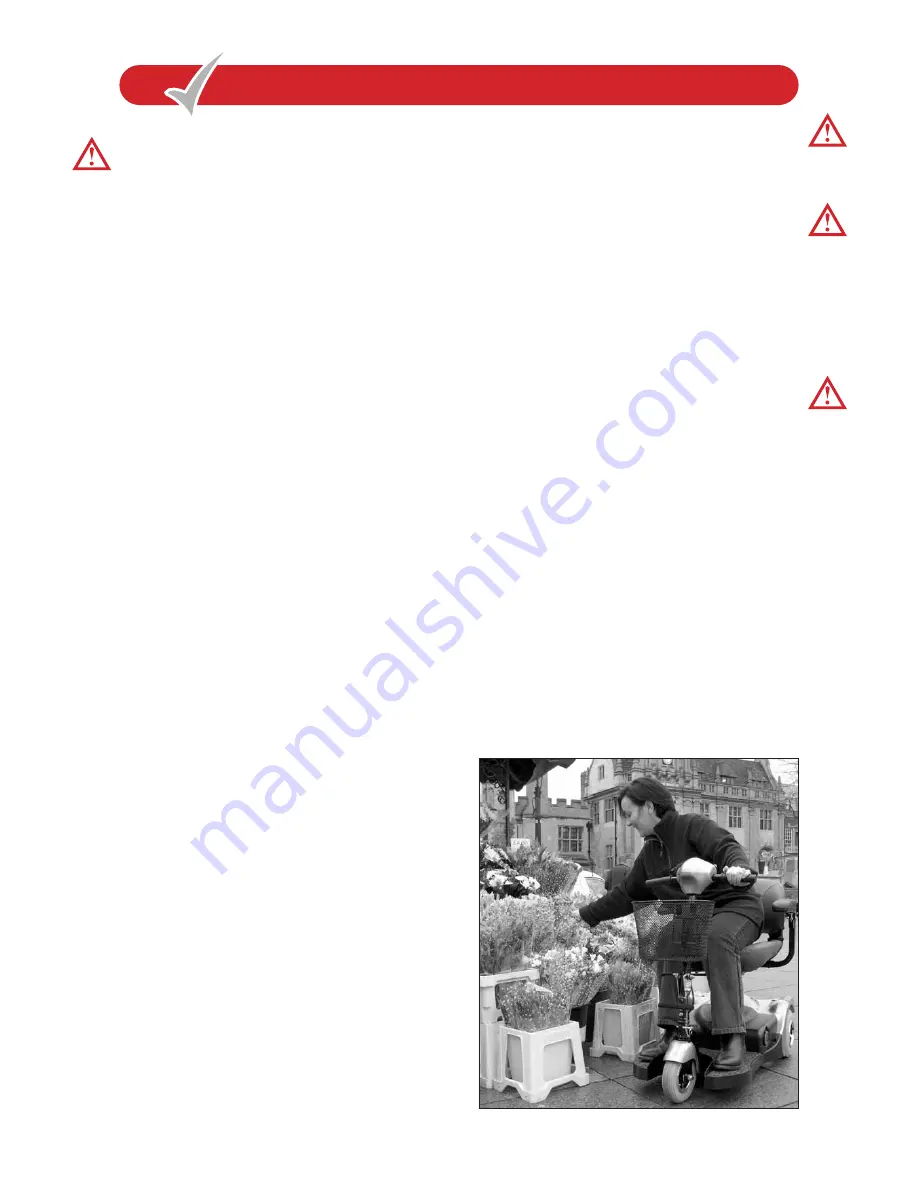
10
SAFETY INSTRUCTIONS & WARNINGS
SAFETY INSTRUCTIONS & WARNINGS
GENERAL
Warning:
Do not attempt to operate your new Companion
Scooter for the first time without completely reading and
understanding all of the facts in this Users Instruction
Manual.
Your Companion Scooter is a state-of-the-art device
designed to enhance and increase your mobility. Freerider
provides a range of Scooters to best suit the individual
needs and circumstance of the Scooter user.
Please be aware that the final selection and purchasing
decision regarding the model of Scooter to be used is the
responsibility of the Scooter user who is capable of making
such a decision with assistance from his/her healthcare
professional (i.e. medical doctor, physical therapist etc.)
The contents of this Users Instruction Manual are based on
the expectation that the mobility device expert has properly
fitted the Scooter to the user and has assisted the
prescribing healthcare professional and/or the authorised
Freerider Distributor in the instruction process for the safe
use of the scooter.
There are certain situations, including some medical
conditions, where the Scooter user will need to practice
operating the Companion in the presence of a trained
attendant. A trained attendant can be defined as a family
member or care professional specially trained in assisting a
Scooter user in various daily living activities.
When you begin to use your Companion Scooter, you will
probably encounter situations in which you will need some
practice. Simply take your time and you will soon become
confident and in control as you manoeuvre through doorways,
on and off elevators, up and down ramps and over moderate
terrain. Below are some tips, precautions and other safety
measures that will help you to become accustomed to the safe
operation of your Companion Scooter.
Your Companion Scooter is fitted with a number of “Safety
Warning Instruction” label (see page 13).
These labels communicate important warnings or instructions -
Please familiarise yourself with their location.
SAFETY CHECK
Get to know the feel of your Companion Scooter and it’s
capabilities. Freerider recommends that you perform a safety
check before each use to make certain your Scooter operates
smoothly and safely. For details on how to perform these
necessary inspections, see the Care and Maintenance section
of this manual. Perform the following inspection prior to using
your Companion Scooter.
Check tyre inflation, maintain at 30 p.s.i. (210 kpa)
Check all battery connections, make certain they are
serviceable and not corroded.
Check front basket is fitted correctly.
Check batteries have been fully charged.
Check operation of brakes.
Warning:
It is critical that the pressure in the pneumatic tyres
is maintained at 30 p.s.i. (210 kpa) at all times. Failure to
observe this warning may result in a serious failure of the tyre
or wheel, causing serious personal injury and/or damage to
your Scooter.
Warning:
Do not carry passengers on your Companion. Your
Scooter is designed for a single occupant which complies with
legal requirements for pavement vehicles. Carrying passengers
on your Scooter may result in personal injury and/or property
damage.
WEIGHT LIMIT
Your Companion Scooter is designed for a maximum user
weight limit of 114kg (252lbs)(18 stone).
Warning:
Exceeding the weight limit will void your warranty
and may result in personal injury and damage to your scooter.
Freerider will not be held responsible for injuries and/or
property damage resulting from failure to observe these weight
limitations. Please also remember when carrying heavy objects
that this will increase your total weight and may make your
Scooter unstable.
CORNERING
Excessively high cornering speeds can create the possibility of
tipping. Factors which affect the possibility of tipping include,
but are not limited to, cornering speed, steering angle (how
sharply you are turning), uneven surfaces, inclined surfaces
(such as heavily cambered pavements), riding from an area of
low traction to an area of high traction (such as passing from
grass areas to a paved area - especially at high speed while
turning), and abrupt directional changes. Do not corner at high
speed! If you feel that you may tip over in a corner, reduce
your speed and steering angle to prevent your Scooter from
tipping.











































